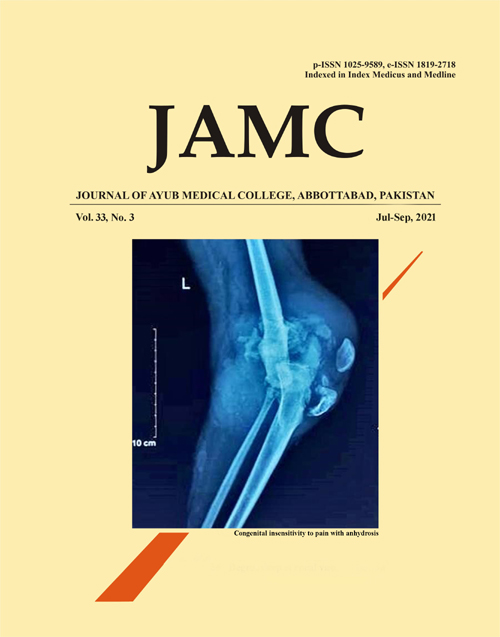WHY MYRINGOPLSTIES FAIL? IMPACT OF RELEVANT CLINICAL FACTORS ON THE SURGICAL OUTCOME; A STUDY FROM PAKISTAN
Abstract
Background: Myringoplasty is the reconstruction of the tympanic membrane by grafting. Success varies from 50-100%. A study was conducted to unveil the vital causes for failed myringoplasty with an aim to attenuate graft rejections and augment better outcomes. Methods: It was descriptive case series in which data was retrospectively collected at a tertiary care hospital (Rawalpindi, Pakistan) from January 2009 to December 2018. First 600 consecutive patients who qualified for inclusion/ exclusion criteria, underwent myringoplasties were followed-up for 06 months. Graft Take/Failure, the main outcome variable, was correlated with relevant independent variables. Data was collected on a structured pro forma, approved by hospital ethical committee. Data was analysed using IBM-SPSS-21.0. Results: Out of 600, 164 (27.3%) had graft rejection; failure being significantly enhanced by increasing age (p<0.001), larger perforation (p-0.025), co-morbidities (p<0.001), especially diabetics (p=0.040) and Eustachian tube (p-0.016) dysfunction amongst among systemic and ENT diseases respectively, and discharge-free ear (Dry Ear) for <4 weeks (p<0.001); while best graft take was achieved with end-aural surgical technique (p=0.048). Gender (p-0.897) did not caste a significant impact on graft outcome. Conclusion: The results of various surgical approaches of myringoplasty are equitable. Proper socio-demographic and clinical evaluation can improve graft outcome, and this surgery shall be discouraged in patients with diabetes mellitus and defective Eustachian Tube functions.
References
Khan A, Iqbal K, Khan MI, Marwat M, Khan MN. Outcome of type-1 tympanoplasty: a surgical management of chronic suppurative otitis media. Gomal J Med Sci 2016;14(1):7-10.
Das A, Sen B, Ghosh D, Sengupta A. Myringoplasty: Impact of Size and Site of Perforation on the Success Rate. Otolaryngol Head Neck Surg 2015;67(2):185-9.
Yegin Y, Celik M, Koc AK, Kufeciler L, Elbistanli MS, Kayhan FT. Comparison of temporalis fascia muscle and full-thickness cartilage grafts in type 1 pediatric tympanoplasties. Braz J Otorhinolaryngol 2016;82(6):695-701.
Heo KW. Outcomes of type I tympanoplasty using a cartilage shield graft in patients with poor prognostic factors. Auris Nasus Larynx 2017;44(5):517-21.
Dispenza F, Bennici E, Bianchini S, Scarnà CG, Costantino C, Singh M, et al. Fat plug myringoplasty: Analysis of a safe procedure for small tympanic perforations. Euro Mediterr Biomed J 2015;10(3):87-92.
Awan Z, Bashir H, Hussain A. Myringoplasty: a comparative study of different graft materials and various surgical techniques. Ann Pak Inst Med Sci 2008;4(4):209-11.
Arshad M, Shahnaz A, Bashir M, Zaman A. Comparison of graft uptake in patients undergoing myringoplasty/ tympanoplasty by overlay and underlay procedure. Professional Med J 2019;26(11):1861-5.
Saeed A, Ghamdi AL. Tympanoplasty: factors influencing surgical outcome. Ann Saudi Med 1994;14:483-5.
Ashfaq M, Aasim MU, Khan N. Myringoplasty: anatomical and functional results. Pak Armed Forces Med J 2004;54(2):155-8.
Vartiainen E, Nuutinen J. Success and pitfalls in myringoplasty: follow-up study of 404 cases. Am J Otol 1993;14(3):301-5.
Kotecha B, Fowler S, Topham J. Myringoplasty: A prospective audit study. Clin Otolaryngol Allied Sci 1999;24(2):126-9.
Dispenza F, Battaglia AM, Salvago P, Martines F. Determinants of failure in the reconstruction of the tympanic membtane: A case control study. Iran J Otorhinolaryngol 2018;30(101):341-34.
Dangol K, Shivastav RP. Study of various prognostic factors affecting successful myringoplasty in a tertiary care centre. Int Arch Otorhinolaryngol 2017;21(3):250-4.
Niazi SA, Ahmed A, Usman R, Maqsood A. Effects of a focus of infection in the upper respiratory tract on the outcome of myringoplasties. Khyber Med Univ J 2014;4(3):125-8.
Lee P, Kelly G, Mills RP. Myringoplasty: does the size of the perforation matter? Clin Otolaryngol 2002;27:331-4.
Sajid T, Shah MI, Ghani R, Asif M. Type-I TympanoplastyBy Underlay Technique - Factors Affecting Outcome. J Ayub Med Coll Abottabad 2017;29(2):258-61.
Pignataro L, Grillo Della Berta L, Capaccio P, Zaghis A. Myringoplasty in children: anatomical and functional results. J Laryngol Otol 2001;115(5):369-73.
Denoyelle F, Roger G, Chauvin P, Garabedian EN. Myringoplasty in children: predictive factors of outcome. Laryngoscope 1999;109(1):47-51.
Niazi SA, Hassan Z, Atif K, Ullah S. Comparison of permeatal medial placement of graft without raising the tympano-meatal flaps to conventional methods of myringoplasty: An experience at tertiary care hospital in Pakistan. Pak J Med Sci 2016;32(4):927-30.
Downloads
Published
How to Cite
Issue
Section
License
Journal of Ayub Medical College, Abbottabad is an OPEN ACCESS JOURNAL which means that all content is FREELY available without charge to all users whether registered with the journal or not. The work published by J Ayub Med Coll Abbottabad is licensed and distributed under the creative commons License CC BY ND Attribution-NoDerivs. Material printed in this journal is OPEN to access, and are FREE for use in academic and research work with proper citation. J Ayub Med Coll Abbottabad accepts only original material for publication with the understanding that except for abstracts, no part of the data has been published or will be submitted for publication elsewhere before appearing in J Ayub Med Coll Abbottabad. The Editorial Board of J Ayub Med Coll Abbottabad makes every effort to ensure the accuracy and authenticity of material printed in J Ayub Med Coll Abbottabad. However, conclusions and statements expressed are views of the authors and do not reflect the opinion/policy of J Ayub Med Coll Abbottabad or the Editorial Board.
USERS are allowed to read, download, copy, distribute, print, search, or link to the full texts of the articles, or use them for any other lawful purpose, without asking prior permission from the publisher or the author. This is in accordance with the BOAI definition of open access.
AUTHORS retain the rights of free downloading/unlimited e-print of full text and sharing/disseminating the article without any restriction, by any means including twitter, scholarly collaboration networks such as ResearchGate, Academia.eu, and social media sites such as Twitter, LinkedIn, Google Scholar and any other professional or academic networking site.










